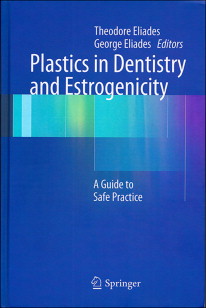
When chemicals with the ability to alter reproductive, neurologic, and metabolic development are found in common items, the attention they draw can become intense. Bisphenol A (BPA) is 1 such chemical. BPA-based materials are used in food and beverage containers, protective coatings, optical lenses, adhesives, powder paints, paper coatings, and dental polymers. Even at low exposures, BPA might cause various adverse effects on reproduction and development, especially during embryonic development.
The latest book to shed light on this topic presents a comprehensive review of our current knowledge of BPA release from dental polymers, including some used by orthodontists. This text was conceived and written by brothers Theodore and George Eliades. Ted heads the Department of Orthodontics and Paediatric Dentistry in Zurich, Switzerland, and is an associate editor of the AJO-DO ; George manages the Department of Biomaterials at the University of Athens in Greece.
As orthodontics is practiced now, adhesives polymers can be exposed to the oral environment in 3 ways: at the peripheral margins of the bracket, during the use of bonded retainers, and after removal of the brackets and cleaning of the enamel surface. When the average adhesive thickness at the margins around brackets is thin, the effect of leaching might not be potent. But when used to bond lingual retainers, light-cured adhesives remain in the mouth for months or years. Kang et al concluded that because evidence of the “low-dose effect” exists after bonding lingual retainers, clinicians should reduce the uncured layer of the material by polishing the surface of the adhesive with pumice. After treatment, when fixed appliances are removed with high-speed rotating instruments, particles are released. This can lead to the development of a potentially hazardous aerosol with the risk of reaching the lungs. Over time, this release can also be of concern to the assisting medical team.
What about the use of clear aligners to straighten teeth? Are they a problem because of their chemical makeup? This seems not to be the case. The fundamental constituent of Invisalign’s aligners is polyurethane. Eliades et al studied this material and failed to demonstrate measureable levels of BPA. Why? First, individual aligners are used for a short time; second, the material used for the aligners, polyurethane, appears to be quite stable.
In summary, the release of BPA is a well-demonstrated phenomenon in oral conditions and requires special clinical handling and further research. Polycarbonate shows evidence of degradation in both in-vitro and in-vivo conditions, which could lead to the release of BPA. The decision to use these materials must balance risk and benefit, and their use in young children and pregnant women should be reconsidered entirely.
When it is necessary to bond a lingual retainer, decreasing the distance of the light-cure tip might reduce the BPA released, as will polishing the surfaces of bonded retainers where adhesive exposure is the greatest. Frequent mouth rinsing during the first hour after placing brackets or bonding a retainer might prevent patient exposure to the potential hazard of leaching monomers. Further assessment of the release of these compounds during orthodontic procedures is needed to better determine the potential risks to clinicians and staff. Also, manufacturers should be encouraged to develop new BPA-free materials as treatment options.
Stay updated, free dental videos. Join our Telegram channel

VIDEdental - Online dental courses


